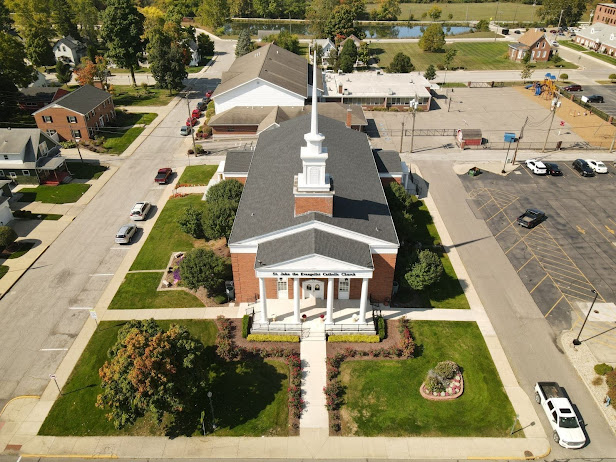Saint John the Evangelist
Goshen, Indiana
This church is situated on Indiana State Road 15/Main Street. This parish is one of the oldest in the diocese, but ironically the buildings on the campus are not older than the 1960's. The parish was a mission back in the 1860's and was a fairly small church. In the 1940's a small addition was added but by the late 50's the church was simply too small for the ever growing congregation
After Vatican II, the Very Reverend James Cis, gave two plans to the parish for a new church to be built. The first was a extravagant modern design, the second was a more conservative colonial design. These photos demonstrate the decision made toward the latter. It's ironic, the church was completed and dedicated in 1970, but retained many pre-Vatican II traditions, such as a communion rail, and large rectangular altar, (as the norm during the time was to build small squarish altars resembling coffee tables.)
The church is just off the Goshen Downtown, and has been a staple of the skyline for 50 years. It's so well known that in past years a local bookstore made trinkets of famous Goshen landmarks, only two were churches and one was of Saint John's
Since the 1990's the Hispanic and Latino population in Goshen has exploded to the point where half of the Masses at Saint John's are in Spanish and most of them are standing room only. Their addition has led to several visible reminders of their devotion. This statue of Our Lady of Guadalupe is only a fragment of the manifested devotion.
Another early 2000's introduction was the statue of the Pieta and the stations of the cross.
The school building on the left was yet another addition to the parochial school campus in the early 2000's. The original school dates back to the late 1800's, and an addition was added in the 60's, but the original building was demolished to make way for the current structure
In the late 70's a few years after the construction of the church, a grotto to Our Lady was built with the help of several parishioners for manual labor. A time capsule was encased in the grotto by a placard with a poem written by another parishioner
The interior is definitely Colonial, yet it while Colonial churches tend to be Protestant, this is clearly Catholic. It makes for some interesting architectural choices. Unfortunately an 1990's renovation saw the cutting down of the altar and removal of the communion rail.
The first is the massive altar stage. A necessary element in post Vatican II churches but an anomaly in Colonial churches. The stand on which the tabernacle sits also has an altar stone, technically making it an altar
The second interesting decision made was the the use of plain glass rather than stained glass. While some Colonial churches have stained glass, they do not compare with the rich visual tapestry of stained glass found in a Gothic or Romanesque Catholic church. Simply put, there is no such thing as Colonial stained glass in the Catholic Church, and if there is, it is a rarity/
This rose window, obscurely placed in the choir loft, was a remnant of the former church
Unfortunately the statuary is not consistent. On the statues of the patron of the parish and the Sacred Heart flanking the tabernacle, as well as the stations, they are a wooden, monochromatic color. On the other hand, the statues of the Blessed Mother and Saint Joseph on either side of the sanctuary, as well as the altar crucifix, are painted statues
In most North American churches, the Blessed Mother and Saint Joseph have side altars that flank the sanctuary. (Sometimes Saint Joseph is swapped for the Sacred Heart in Polish churches.)

















No comments:
Post a Comment